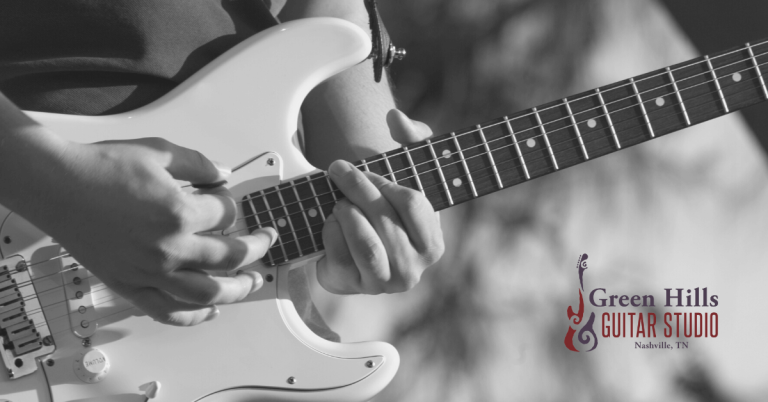Developing Techniques for Lead Guitar Playing
Guitar solos serve as the ultimate expression of a guitarist’s individuality and skill, bridging the rhythmic backbone of a song with moments of virtuosity and emotion. Whether drawn to the soulful bends of B.B. King or the electrifying techniques of Eddie Van Halen, each solo reflects the unique personality of its player.
For many aspiring guitarists, the allure of solos is what initially ignites their passion for the instrument. While developing an understanding of chords and scales is foundational, the true thrill lies in crafting your own solos, translating the essence of a song into a personal musical narrative.
While soloing may appear daunting, the joy is well worth the effort. Aspiring guitarists can unlock the ability to create and perform their own solos by starting with the basics and gradually building techniques.
Before we dive, check out this video from Sam Farkas to learn the secret sauce for tasty lead lines!
Foundational Skills: Music Theory for Playing Lead Guitar
To become proficient at playing lead guitar, it is essential to develop a solid foundation of skills and knowledge. These fundamental elements provide the building blocks for crafting compelling and expressive lead guitar lines.
Let’s explore the essential skills and knowledge areas that aspiring guitarists should prioritize to excel in lead guitar playing:
- Scales: Scales are the building blocks of music, providing the framework for melodies and solos. By learning scales such as the pentatonic, blues, and major scales, guitarists gain a deeper understanding of the fretboard and how notes harmonize. Practice scale runs, sequences, and interval drills to develop fluency and agility across the fretboard.
- Chords: While solos often focus on single-note melodies, understanding chords is essential for crafting harmonically rich and melodically satisfying solos. Learn common chord shapes and progressions and how to arpeggiate chords to create melodic passages within your solos. Experiment with chord inversions and voicings to add color and depth to your playing.
- Arpeggios: Arpeggios are broken chords that consist of the individual notes of a chord played one after the other. They are essential for adding melodic interest and harmonic movement to guitar solos. Practice arpeggio patterns across different chord types (major, minor, dominant, etc.) and incorporate them into your soloing vocabulary to create fluid and expressive lines.
- Technique: Solid technique is crucial for executing guitar solos with precision and flair. Focus on various picking techniques, legato (hammer-ons and pull-offs), string bending, vibrato, and sliding. Practice exercises designed to improve each aspect of your technique, gradually increasing speed and accuracy over time.
- Ear Training: Cultivating a good ear is essential for improvisation and creating solos on the fly. Train your ear by transcribing solos and melodies by ear, identifying intervals, and learning to play along with backing tracks in different keys and styles. This will help you develop a deeper connection to the music and enable you to express yourself more freely through your solos.
By sharpening these foundational skills, aspiring guitarists empower themselves to unleash their creativity and expression in soloing. Stay dedicated to practicing by cultivating patience!
Technique Development: The Mechanics of Lead Guitar Playing
Executing captivating guitar solos requires more than just musical knowledge—it demands refined technique and precise execution.
Here, we’ll discuss essential tips and drills to enhance your pick control, finger dexterity, and overall playing technique and imbue your solos with precision and flair.
- Pick Control: The pick is your primary tool for articulating notes and shaping your sound. Focus on maintaining a relaxed grip and consistent pick angle to achieve optimal tone and clarity. Experiment with different pick materials and thicknesses to find what best suits your playing style. Practice exercises such as string-crossing drills and dynamic picking patterns to refine your pick control and dynamics.
- Finger Dexterity: Developing agility and strength in your fretting fingers is essential for navigating the fretboard with ease and precision. Warm up with finger exercises such as chromatic runs, spider crawls, and trill drills to limber up your fingers and improve coordination. Incorporate legato techniques like hammer-ons, pull-offs, and slides into your practice routine to gradually build finger strength and dexterity.
- Overall Playing Technique: A solid foundation of overall playing technique is crucial for executing solos with finesse and confidence. Focus on aspects such as hand positioning, posture, and relaxation to minimize tension and maximize efficiency in your playing. Practice scales, arpeggios, and licks with a metronome to develop rhythmic accuracy and internalize different patterns and sequences.
By dedicating focused practice time to these critical areas of technique development, you’ll gradually refine your skills and elevate your soloing abilities to new heights.
Remember to start slowly and gradually increase tempo and complexity as you become more comfortable with each exercise. With persistence and dedication, you’ll cultivate the technical proficiency to execute solos with precision, flair, and undeniable musicality.
Check out this playlist from Green Hills Guitar Studio owner Shane Lamb for developing finger strength and dexterity while also working on your hammer-ons and pull-offs!
Improvisation Techniques: Unleashing Your Creative Voice
Learning the art of improvisation is essential for any guitarist looking to add spontaneity and personal expression to their playing. Here, we’ll explore various approaches to improvisation, empowering you to develop your unique musical voice.
- Playing by Ear: Learning to play by ear is a valuable skill that allows you to spontaneously create melodies and solos without relying on sheet music or tablature. Train your ear by listening to songs and trying to replicate melodies and solos by ear. Focus on identifying intervals, recognizing chord progressions, and understanding the nuances of phrasing and rhythm.
- Understanding Chord Progressions: A solid understanding of chord progressions is crucial for effective improvisation. Learn common chord progressions found in different styles of music, such as the 12-bar blues or jazz standards. Practice improvising over these progressions, experimenting with different scales, arpeggios, and melodic motifs to create engaging and harmonically rich solos.
- Developing a Vocabulary of Licks and Phrases: Building a vocabulary of licks and phrases is like having a toolbox of musical ideas. Transcribe solos from your favorite guitarists, analyze their phrasing and note choices, and incorporate these ideas into your playing. Experiment with modifying and combining licks to create your unique musical statements.
By exploring and incorporating these improvisation techniques into your practice routine, you’ll expand your musical horizons and develop the confidence to improvise freely and creatively in any musical context. Remember to embrace experimentation and allow your intuition and musical instincts to guide you as you explore the exciting world of improvisation.
Check out this video from Green Hills Guitar Studio instructor Sam Farkas for tips on learning musical vocabulary!
Studying Iconic Solos: Decoding the Legends
Analyzing iconic guitar solos is a gateway to mastering lead guitar playing. By dissecting the techniques and concepts employed by legendary players, you’ll find both inspiration and practical guidance for crafting original solos.
23 Guitar Solos Worthy of Study:
- “Europa” by Santana (Carlos Santana): This soulful ballad showcases Santana’s mastery of phrasing and expression through techniques such as vibrato and bending. Pay attention to his use of modal playing and melodic embellishments to evoke emotion.
- “Jessica” by The Allman Brothers Band (Dickey Betts): Betts’ iconic instrumental piece features intricate dual-guitar harmonies and slide guitar techniques. Study his use of major pentatonic scales and sliding techniques to create smooth, flowing melodies.
- “Cause We’ve Ended as Lovers” by Jeff Beck: Beck’s emotive playing in this jazz-fusion classic demonstrates his command of dynamics and phrasing. Focus on his use of hybrid picking and chromaticism to create tension and release within the solo.
- “Little Wing” by Stevie Ray Vaughan: Vaughan’s rendition of this Jimi Hendrix classic showcases his mastery of blues phrasing and string bending. Analyze his use of double stops and aggressive picking to emulate his fiery, expressive style.
- “Maggot Brain” by Funkadelic (Eddie Hazel): Hazel’s psychedelic masterpiece features extended soloing over a minimalistic backing track. Explore his use of feedback, wah-wah pedal, and unconventional scales to create a haunting and otherworldly atmosphere.
- “Autumn Leaves” by Joe Pass: Pass’s solo guitar arrangement of this jazz standard highlights his unparalleled fingerstyle technique and chord melody playing. Study his use of walking bass lines, chord substitutions, and chord melody concepts to expand your harmonic vocabulary.
- “Bright Size Life” by Pat Metheny: Metheny’s fusion masterpiece showcases his melodic sensibility and innovative use of guitar synthesizers. Pay attention to his use of intervallic leaps, harmonics, and tapping techniques to create rich, textured layers of sound.
- “La Villa Strangiato” by Rush (Alex Lifeson): Lifeson’s progressive rock epic features complex arrangements and virtuosic soloing. Analyze his use of arpeggios, alternate picking, and modal interchange to navigate diverse musical landscapes.
- “Always with Me, Always with You” by Joe Satriani: Satriani’s melodic rock ballad demonstrates his signature legato technique and melodic phrasing. Focus on his use of modal interchange and pitch axis theory to create memorable melodies and solos.
- “Parisienne Walkways” by Gary Moore: Moore’s blues-rock classic showcases his emotive vibrato and blistering pentatonic runs. Study his use of call-and-response phrasing and bending techniques to inject passion and intensity into your playing.
- “233 Butler” by Julian Lage: Lage’s contemporary jazz composition demonstrates his innovative approach to harmony and improvisation. Pay attention to his use of chord substitutions, melodic development, and rhythmic complexity to create a fresh and dynamic soloing style.
- “Shenandoah” by Tony Rice: Rice’s acoustic rendition of this traditional folk song showcases his impeccable flatpicking technique and tasteful interpretation of melody. Study his use of crosspicking and open-string drones to achieve a full and resonant acoustic sound.
- “Impossible Germany” by Wilco (Nels Cline): Cline’s extended solo in this indie rock gem showcases his experimental approach to tone and texture. Analyze his use of effects pedals, unconventional scales, and free-form improvisation to create a dynamic and unpredictable soloing style.
- “Comfortably Numb” by Pink Floyd (David Gilmour): Gilmour’s legendary guitar solo in this Pink Floyd classic epitomizes his expressive playing style and mastery of tone. Pay attention to his use of bending, vibrato, and sustain to create a soaring and expressive solo.
- “Hide Away” by Freddie King: King’s instrumental blues classic features blistering single-note runs and expressive string bends. Study his use of call-and-response phrasing and rhythmic accents to emulate his dynamic and energetic soloing style.
- “Four on Six” by Wes Montgomery: Montgomery’s jazz standard showcases his innovative use of octaves and chord melodies. Focus on his impeccable thumb technique and use of melodic embellishments to create a smooth and lyrical soloing style.
- “Master of Puppets” by Metallica (Kirk Hammett): Hammett’s shredding guitar solo in this thrash metal anthem demonstrates his speed and precision. Analyze his use of alternate picking, palm muting, and harmonic squeals to achieve an aggressive and intense soloing style.
- “Gravity” by John Mayer: Mayer’s blues-infused pop hit features a soulful guitar solo that showcases his melodic phrasing and use of dynamics. Pay attention to his use of bending, slides, and tasteful note choices to convey emotion and depth in the solo.
- “Runaway” by Jamiroquai (Rob Harris): Harris’ guitar solo in this funk-infused track features a blend of jazz, funk, and disco influences. Analyze his use of chromaticism, wah-wah pedal, and staccato rhythms to create a dynamic and groovy solo.
- “Dosed” by Red Hot Chili Peppers (John Frusciante): Frusciante’s guitar solo in this psychedelic rock ballad features dreamy textures and melodic motifs. Pay attention to his subtle use of delay, modulation effects, and melodic layering to create a lush and atmospheric solo.
- “Do I Wanna Know?” by Arctic Monkeys (Jamie Cook): Cook’s guitar solo in this indie rock track features a hypnotic riff and atmospheric effects. Pay attention to his use of slides, bends, and ambient delay to create a brooding and evocative solo.
- “Tamacun” by Rodrigo y Gabriela (Rodrigo Sánchez and Gabriela Quintero): Sánchez and Quintero’s instrumental acoustic guitar duet showcases their virtuosic fingerstyle playing and rhythmic precision. Study their percussive techniques, rapid-fire arpeggios, and flamenco-inspired flourishes to create a high-energy and intricate musical dialogue.
- “Minor Swing” by Django Reinhardt: Reinhardt’s seminal gypsy jazz composition showcases his unparalleled virtuosity and innovative approach to guitar playing. Pay close attention to his lightning-fast arpeggios, chromatic runs, and rhythmic variations to capture the essence of his dynamic and expressive soloing style.
Analyzing iconic guitar solos is a gateway to unlocking new techniques, concepts, and musical expressions in your journey to master lead guitar playing. By dissecting the methods and concepts employed by legendary players, you’ll find both inspiration and practical guidance for crafting original solos.
While the list of recommended guitar solos offers valuable insights into lead guitar playing across various genres, it’s also beneficial to draw inspiration from instrumentalists other than guitar players. Exploring the work of saxophonists, pianists, and other instrumentalists can offer fresh perspectives on melody, phrasing, and improvisation that can enrich your playing style.
By immersing yourself in a diverse range of musical styles and studying the techniques of guitarists and instrumentalists from other disciplines, you can expand your musical vocabulary and develop a unique voice on the instrument.
Practice Strategies: Refining Your Lead Guitar Playing Skills
Effective practice routines are essential for honing soloing skills and mastering the guitar. Here, we suggest strategies to enhance your soloing abilities by incorporating scales, chords, and improvisation exercises into your daily practice sessions.
- Structured Practice Routines: Begin each session with a structured plan to maximize efficiency and productivity. Allocate dedicated time slots for scales, chords, and improvisation exercises, ensuring a well-rounded approach to skill development.
- Scale Exercises: Practice scales in various positions and patterns across the fretboard. Incorporate scale runs, sequences, and interval drills into your routine to focus on building speed, accuracy, and fluency. Gradually increase the tempo as you become more comfortable with each scale.
- Chord Progressions: Integrate chord progressions into your practice sessions to develop a strong foundation for soloing. Practice common chord progressions in different keys and styles, experimenting with arpeggios and chord inversions to create melodic passages within your solos.
- Improvisation Exercises: Dedicate time to improvisation exercises that encourage spontaneous creativity and expression. Play along with backing tracks or jam with other musicians to develop your real-life improvisational skills. Expand your soloing vocabulary by exploring different scales, modes, and melodic motifs.
- Recording and Self-Assessment: Record your practice sessions and soloing exercises to track your progress. Listen back to your recordings critically, identifying areas for improvement and setting specific goals for future practice sessions.
By incorporating these practice strategies into your daily routine, you’ll gradually refine your soloing skills and become a more confident and versatile guitarist. Remember to stay disciplined and focused during practice, and above all, enjoy the journey of musical growth and exploration.
The Coda
In your journey to master lead guitar playing, you’ll discover a world filled with excitement, creativity, and growth. From dissecting iconic solos to refining your technique and embracing improvisation, you have a wealth of resources to unlock your full potential on the instrument.
By dedicating time to developing foundational skills, such as scales, chords, and ear training, and incorporating effective practice strategies into your routine, you can prepare for expressive and captivating soloing.
At Green Hills Guitar Studio, we’re here to support you every step of the way. Whether you’re in Nashville or joining us online, our experienced instructors offer personalized guitar lessons tailored to your unique interests and aspirations.
Take the next step in your musical journey and unleash your creativity with guitar lessons from Green Hills Guitar Studio. Contact us today to schedule your first lesson and embark on an exciting adventure in lead guitar playing.





